Toyota Avalon 2022 Do-it-yourself maintenance
In the age of modern cars, the DIY (do-it-yourself) repair culture of the year 2022 is a mix of the old and the new. Car fans and regular drivers are both taking care of their cars more and more on their own. They do this because they want to save money, because it makes them feel good, and because there are so many online instructions. Modern cars, like the 2022 models, have complex systems, sensors, and electronics that can seem hard to work with. However, with the right tools and instructions, many chores, like oil changes and air filter replacements, are still doable by the average person. DIYers can now use the power of technology to find detailed instructions, videos, and forums for their particular vehicle model. This makes maintenance chores easier to do. Even though the DIY spirit is strong, it’s important to be careful and make sure you have the right tools and the right knowledge. This will keep you safe and keep the vehicle in good shape.
Toyota Avalon 2022 Do-it-yourself service precautions
Do-it-yourself service precautions
If you perform maintenance by yourself, be sure to follow the correct procedure as given in these sections
| Items | Parts and tools |
| Battery condition | • Warm water • Baking soda • Grease
• Conventional wrench (for terminal clamp bolts) |
|
Brake fluid level |
• SAE J1703 or FMVSS No.116 DOT 3 SAE J1704 or FMVSS No.116 DOT 4
• Rag or paper towel • Funnel (used only for adding brake fluid) |
|
Engine coolant level |
• “Toyota Super Long Life Coolant” or a similar high quality ethylene glycol-based non-silicate, non- amine, non-nitrite and non-borate coolant with long- life hybrid organic acid technology
U.S.A.: “Toyota Super Long Life Coolant” is pre-mixed with 50% coolant and 50% deionized water. Canada: “Toyota Super Long Life Coolant” is pre-mixed with 55% coolant and 45% deionized water. • Funnel (used only for adding engine coolant) |
| Engine oil level | • “Toyota Genuine Motor Oil” or equivalent
• Rag or paper towel • Funnel (used only for adding engine oil) |
| Fuses | • Fuse with same amperage rating as original |
| Radiator/con- denser | ¾ |
| Tire inflation pressure
|
• Tire pressure gauge
• Compressed air source |
| Washer fluid | • Water or washer fluid containing antifreeze (for win- ter use)
• Funnel (used only for adding water or washer fluid) |
WARNING
- The engine compartment contains many mechanisms and fluids that may move suddenly, become hot, or become electrically energized. To avoid death or serious injury, observe the following precautions.
- When working on the engine compartment
- Keep hands, clothing and tools away from the moving fans and engine drive belt.
- Be careful not to touch the engine, radiator, exhaust manifold, etc. right after driving as they may be hot. Oil and other fluids may also be hot.
- Do not leave anything that may burn easily, such as paper and rags, in the engine compartment.
- Do not smoke, cause sparks or expose an open flame to fuel or the battery. Fuel and battery fumes are flammable.
- Be extremely cautious when working on the battery. It contains poisonous and corrosive sulfuric acid.
- When working near the electric cooling fans or radiator grille Be sure the engine switch is off. With the engine switch in ON, the electric cooling fans may automatically start to run if the air conditioning is on and/or the coolant temperature is high.
- Safety glasses Wear safety glasses to prevent flying or falling material, fluid spray, etc. from getting in your eyes.
NOTICE
- If you remove the air cleaner filter
- Driving with the air cleaner filter removed may cause excessive engine wear due to dirt in the air.
Hood
Opening the hood
- Pull the hood lock release lever. The hood will pop up slightly

- Pull up the auxiliary catch lever and lift the hood.
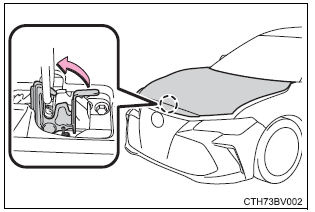
Open hood warning buzzer
If the vehicle reaches a speed of 3 mph (5 km/h), the master warning light flashes, and a buzzer sounds to indicate that the hood is not fully closed
WARNING
- Pre-driving check
- Check that the hood is fully closed and locked.
- If the hood is not locked properly, it may open while the vehicle is in motion and cause an accident, which may result in death or serious injury.
Positioning a floor jack
When using a floor jack, follow the instructions in the manual provided with the jack and perform the operation safely. When raising your vehicle with a floor jack, position the jack correctly. Improper placement may damage your vehicle or cause injury.
Location of the jack point
Front Rear
Rear
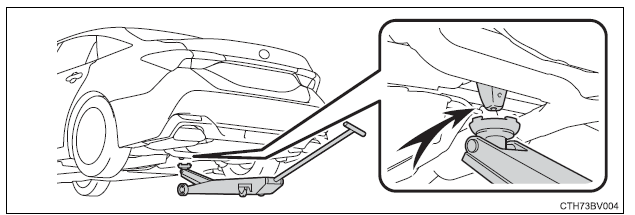
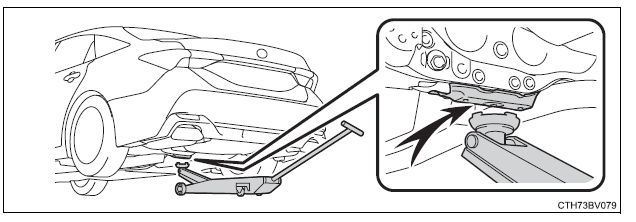
Engine compartment
Components
2.5 L 4-cylinder (A25A-FKS) engine
- Fuse boxes (if equipped)
- Engine oil filler cap
- Engine oil level dipstick
- Brake fluid reservoir
- Battery
- Radiator
- Electric cooling fan
- Condenser
- Engine coolant reservoir
- Washer fluid tank
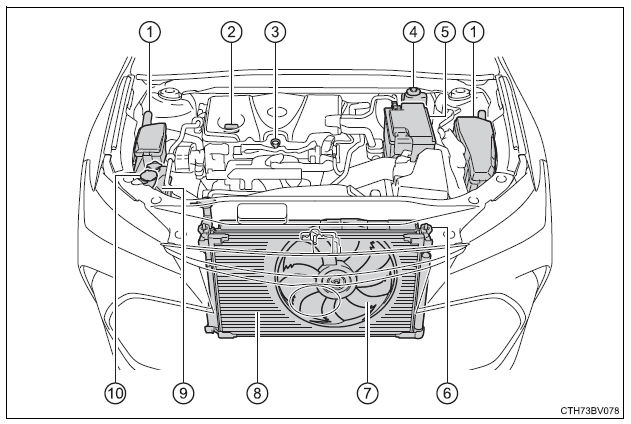
3.5 L V6 (2GR-FKS) engine
- Fuse boxes (if equipped)
- Engine oil filler cap
- Engine oil level dipstick
- Brake fluid reservoir
- Battery
- Radiator
- Electric cooling fan
- Condenser
- Engine coolant reservoir
- Washer fluid tank
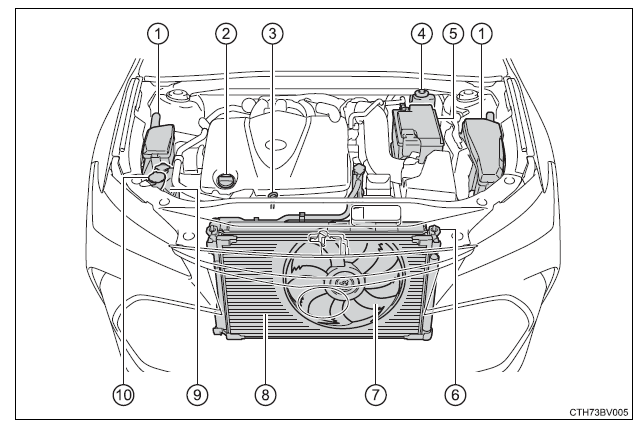
Engine oil
With the engine at operating temperature and turned off, check the oil level on the dipstick
■ Checking the engine oil
- Park the vehicle on level ground. After warming up the engine and turning it off, wait more than 5 minutes for the oil to drain back into the bottom of the engine.
- Holding a rag under the end, pull the dipstick out.
2.5 L 4-cylinder (A25A-FKS) engine/ 3.5 L V6 (2GR-FKS) engine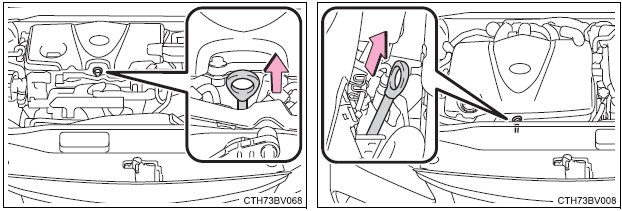
- Wipe the dipstick clean.
- Reinsert the dipstick fully.
- Holding a rag under the end, pull the dipstick out and check the oil level.
- Low
- Normal
- Excessive
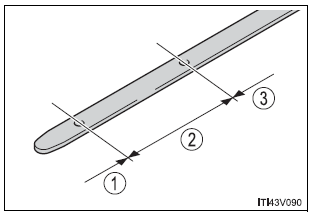
- The shape of the dipstick may differ depending on the type of vehicle or engine.
- Wipe the dipstick and reinsert it fully.
Adding engine oil
If the oil level is below or near the low level mark, add engine oil of the same type as that already in the engine.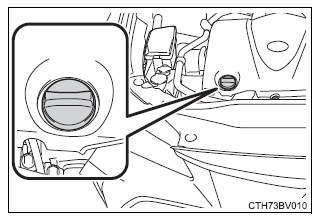
- Remove the oil filler cap by turning it counterclockwise.
- Add engine oil slowly, checking the dipstick.
- Install the oil filler cap by turning it clockwise.
Engine oil consumption
- A certain amount of engine oil will be consumed while driving. In the following situations, oil consumption may increase, and engine oil may need to be refilled in between oil maintenance intervals.
- When the engine is new, for example directly after purchasing the vehicle or after replacing the engine
- If low quality oil or oil of an inappropriate viscosity is used
- When driving at high engine speeds or with a heavy load, or when driving while accelerating or decelerating frequently
- When leaving the engine idling for a long time, or when driving frequently through heavy traffic
WARNING
Used engine oil
- Used engine oil contains potentially harmful contaminants which may cause skin disorders such as inflammation and skin cancer, so care should be taken to avoid prolonged and repeated contact. To remove used engine oil from your skin, wash thoroughly with soap and water.
- Dispose of used oil and filters only in a safe and acceptable manner. Do not dispose of used oil and filters in household trash, in sewers or onto the ground. Call your Toyota dealer, service station or auto parts store for information concerning recycling or disposal.
- Do not leave used engine oil within the reach of children.
NOTICE
To prevent serious engine damage Check the oil level on a regular basis.
When replacing the engine oil
- Be careful not to spill engine oil on the vehicle components.
- Avoid overfilling, or the engine could be damaged.
- Check the oil level on the dipstick every time you refill the vehicle.
- Be sure the engine oil filler cap is properly tightened.
Checking the coolant
The coolant level is satisfactory if it is between the “FULL” and “LOW” lines on the reservoir when the engine is cold.
Engine coolant reservoir
- Reservoir cap
- “FULL” line
- “LOW” line
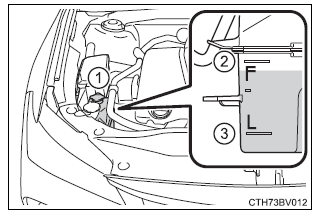
If the level is on or below the “LOW” line, add coolant up to the “FULL” line.
Coolant selection
Only use “Toyota Super Long Life Coolant” or a similar high quality ethylene glycol based non-silicate, non-amine, non-nitrite, and non-borate coolant with long-life hybrid organic acid technology. U.S.A.: “Toyota Super Long Life Coolant” is a mixture of 50% coolant and 50% deionized water. (Minimum temperature: -31F [-35C]) Canada: “Toyota Super Long Life Coolant” is a mixture of 55% coolant and 45% deionized water. (Minimum temperature: -44F [-42C]) For more details about engine coolant, contact your Toyota dealer.
If the coolant level drops within a short time of replenishing
Visually check the radiator, hoses, engine coolant reservoir caps, drain cock and water pump. If you cannot find a leak, have your Toyota dealer test the cap and check for leaks in the cooling system.
WARNING
When the engine is hot Do not remove the engine coolant reservoir cap. The cooling system may be under pressure and may spray hot coolant if the cap is removed, causing serious injuries, such as burns.
NOTICE
When adding coolant Coolant is neither plain water nor straight antifreeze. The correct mixture of water and antifreeze must be used to provide proper lubrication, corrosion protection and cooling. Be sure to read the antifreeze or coolant label
If you spill coolant
Be sure to wash it off with water to prevent it from damaging parts or paint.
Checking the radiator and condenser
Check the radiator and condenser and clear away any foreign objects. If either of the above parts is extremely dirty or you are not sure of their condition, have your vehicle inspected by your Toyota dealer.
WARNING
When the engine is hot Do not touch the radiator or condenser as they may be hot and cause serious injuries, such as burns.
Checking and adding the brake fluid and clutch fluid
Checking fluid level The brake fluid and clutch fluid level should be between the “MAX” and “MIN” lines on the tank
Brake Fluid
Checking fluid level The brake fluid level should be between the “MAX” and “MIN” lines on the tank.
- “MAX”
- “MIN”
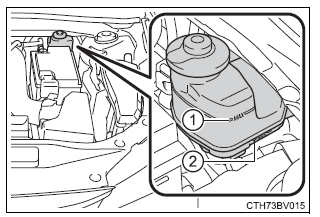
Adding fluid
Make sure to check the fluid type and prepare the necessary item.
- Fluid type SAE J1703 or FMVSS No.116 DOT 3 brake fluid /SAE J1704 or FMVSS No.116 DOT 4 brake fluid
- Item Clean funnel
Brake fluid can absorb moisture from the air
Excess moisture in the brake fluid can cause a dangerous loss of braking efficiency. Use only newly opened brake fluid.
WARNING
When filling the reservoir Take care as brake fluid and clutch fluid can harm your hands and eyes and damage painted surfaces. If fluid gets on your hands or in your eyes, flush the affected area with clean water immediately. If you still experience discomfort, see a doctor.
NOTICE
- If the fluid level is low or high It is normal for the brake fluid level to go down slightly as the brake pads wear out or when the fluid level in the accumulator is high.
- If the reservoir needs frequent refilling, there may be a serious problem.
Battery
Check the battery as follows.
Battery exterior
Make sure that the battery terminals are not corroded and that there are no loose connections, cracks, or loose clamps.
- Hold-down clamp
- Terminals

Before recharging
- When recharging, the battery produces hydrogen gas which is flammable and explosive. Therefore observe the following before recharging:
- If recharging with the battery installed on the vehicle, be sure to disconnect the ground cable.
- Make sure the power switch on the charger is off when connecting and disconnecting the charger cables to the battery.
After recharging/reconnecting the battery
- Unlocking the doors using the smart key system may not be possible immediately after reconnecting the battery. If this happens, use the wireless remote control or the mechanical key to lock/unlock the doors.
- Start the engine with the engine switch in ACC. The engine may not start with the engine switch turned off. However, the engine will operate normally from the second attempt.
- The engine switch mode is recorded by the vehicle. If the battery is disconnected and reconnected, the vehicle will return the engine switch mode to the status it was in before the battery was disconnected. Make sure to turn off the engine before disconnecting the battery. Take extra care when connecting the battery if the engine switch mode prior to the battery being disconnected is unknown. If the system will not start even after multiple attempts, contact your Toyota dealer.
WARNING.
Chemicals in the battery
Batteries contain poisonous and corrosive sulfuric acid and may produce hydrogen gas which is flammable and explosive. To reduce the risk of death or serious injury, take the following precautions while working on or near the battery:
- Do not cause sparks by touching the battery terminals with tools.
- Do not smoke or light a match near the battery.
- Avoid contact with eyes, skin and clothes.
- Never inhale or swallow electrolyte.
- Wear protective safety glasses when working near the battery.
- Keep children away from the battery.
Where to safely charge the battery
Always charge the battery in an open area. Do not charge the battery in a garage or closed room where there is insufficient ventilation.
Emergency measures regarding electrolyte
- If electrolyte gets in your eyes Flush your eyes with clean water for at least 15 minutes and get immediate medical attention.
- If possible, continue to apply water with a sponge or cloth while traveling to the nearest medical facility. If electrolyte gets on your skin Wash the affected area thoroughly.
- If you feel pain or burning, get medical attention immediately.
- If electrolyte gets on your clothes It can soak through clothing onto your skin. Immediately take off the clothing and follow the procedure above if necessary.
- If you accidentally swallow electrolyte Drink a large quantity of water or milk. Get emergency medical attention immediately.
NOTICE
- When recharging the battery Never recharge the battery while the engine is running. Also, be sure all accessories are turned off.
- When adding distilled water Avoid overfilling. Water spilled during battery recharging may cause corrosion.
washer fluid
Add washer fluid in the following situations:
- A washer does not work.
- “Windshield Washer Fluid Low” is displayed on the multi-information display.
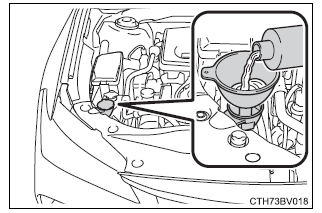
WARNING
When adding washer fluid Do not add washer fluid when the engine is hot or running as washer fluid contains alcohol and may catch fire if spilled on the engine, etc.
NOTICE
- Do not use any fluid other than washer fluid Do not use soapy water or engine antifreeze instead of washer fluid. Doing so may cause streaking on the vehicle’s painted surfaces, as well as damaging the pump leading to problems of the washer fluid not spraying.
- Diluting washer fluid Dilute washer fluid with water as necessary. Refer to the freezing temperatures listed on the label of the washer fluid bottle
Tires
Replace or rotate tires in accordance with maintenance schedules and treadwear.
Checking tires
Check if the treadwear indicators are showing on the tires. Also check the tires for uneven wear, such as excessive wear on one side of the tread. Check the spare tire condition and pressure if not rotated.
- New tread
- Worn tread
- Treadwear indicator
The location of treadwear indicators is shown by a “TWI” or ![]() mark, etc., molded into the sidewall of each tire. Replace the tires if the treadwear indicators are showing on a tire.
mark, etc., molded into the sidewall of each tire. Replace the tires if the treadwear indicators are showing on a tire.
Tire rotation
Rotate the tires in the order shown To equalize tire wear and extend tire life, Toyota recommends that tire rotation is carried out at the same interval as tire inspection. Do not fail to initialize the tire pressure warning system after tire rotation.
Tire pressure warning system
Your vehicle is equipped with a tire pressure warning system that uses tire pressure warning valves and transmitters to detect low tire inflation pressure before serious problems arise.
- The tire pressure detected by the tire pressure warning system can be displayed on the multi-information display

- If the tire pressure drops below a predetermined level, the driver is warned by a screen display and a warning light.
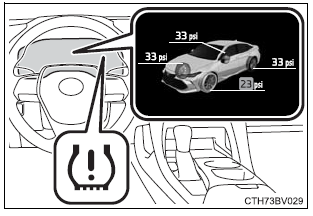
Installing tire pressure warning valves and transmitters
When replacing the tires or wheels, the tire pressure warning valve and transmitters must be installed to the wheels which will be installed to the vehicle. When new tire pressure warning valve and transmitters are installed, new ID codes must be registered in the tire pressure warning computer and the tire pressure warning system must be initialized.
Replacing tires and wheels
If the ID code of the tire pressure warning valve and transmitter is not registered, the tire pressure warning system will not work properly. After driving for about 20 minutes, the tire pressure warning light blinks for 1 minute and stays on to indicate a system malfunction.
NOTICE
- Repairing or replacing tires, wheels, tire pressure warning valves, transmitters, and tire valve caps
- When removing or fitting the wheels, tires, or the tire pressure warning valves and transmitters, contact your Toyota dealer as the tire pressure warning valves and transmitters may be damaged if not handled correctly.
NOTICE
- Make sure to install the tire valve caps. If the tire valve caps are not installed, water could enter the tire pressure warning valves and the tire pressure warning valves could be bound.
- When replacing tire valve caps, do not use tire valve caps other than those specified. The cap may become stuck.
- To avoid damage to the tire pressure warning valves and transmitters
- When a tire is repaired with liquid sealants, the tire pressure warning valve and transmitter may not operate properly.
- If a liquid sealant is used, contact your Toyota dealer or another qualified service shop as soon as possible.
- After use of liquid sealant, make sure to replace the tire pressure warning valve and transmitter when repairing or replacing the tire.
Initializing the tire pressure warning system
- The tire pressure warning system must be initialized in the following circumstances:
- When rotating the tires.
- When the tire inflation pressure is changed such as when changing traveling speed.
- When changing the tire size.
- When the tire pressure warning system is initialized, the current tire inflation pressure is set as the benchmark pressure.
Initializing the tire pressure warning system
The tire pressure warning system must be initialized in the following circumstances:
- When the tire inflation pressure is changed such as when changing traveling speed or load weight.
- When the tire inflation pressure is changed such as when the tire size is changed.
- When rotating the tires.
- After performing the transmitter ID code registration procedure.
- When the tire pressure warning system is initialized, the current tire inflation pressure is set as the benchmark pressure.
How to initialize the tire pressure warning system
- Park the vehicle in a safe place and turn the engine switch off. The initialization procedure cannot be started while the vehicle is moving.
- Adjust the tire inflation pressure to the specified cold tire inflation pressure level.
- Make sure to adjust the tire pressure to the specified cold tire inflation pressure level. The tire pressure warning system will operate based on this pressure level.
- Start the engine
- Select
 on the multi-information display using the meter control switches on the steering wheel.
on the multi-information display using the meter control switches on the steering wheel. - Select
 and then press and hold
and then press and hold .
. - Select “TPWS” and then press

- Select “Set Pressure” then press and hold
 until the tire pressure warning light blinks 3 times. Then a message will be displayed on the multi-information display. “—” will be displayed on the multi-information display for the inflation pressure of each tire while initialization is being performed.
until the tire pressure warning light blinks 3 times. Then a message will be displayed on the multi-information display. “—” will be displayed on the multi-information display for the inflation pressure of each tire while initialization is being performed.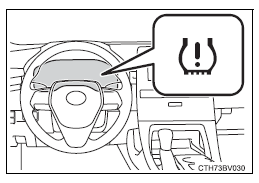
- Drive straight (with occasional left and right turns) at approximately 25 mph (40 km/h) or more for approximately 10 to 30 minutes. Initialization is complete when the position of each tire is determined and the inflation pressure of each tire is displayed on the multi-information display.
- Initialization may take longer than approximately 1 hour in certain situations, such as when the vehicle is stopped for a long time at traffic lights, etc.
Registering ID codes
Every tire pressure warning valve and transmitter has a unique ID code. When replacing a tire pressure warning valve and transmitter, it is necessary to register the ID codes. The ID codes can be registered on of the multi-information display.
of the multi-information display.
How to register the ID codes
- Select
 on the multi-information display using the meter control switches on the steering wheel.
on the multi-information display using the meter control switches on the steering wheel. - Select
 and then press and hold
and then press and hold  .
. - Select “TPWS” and then press
 .
. - Select “Change Wheel” then press and hold
 until the tire pressure warning light blinks slowly 3 times. Then a message will be displayed on the multi-information display. When registration is being performed, the tire pressure warning light will blink for approximately 1 minute then illuminate and “—” will be displayed for the inflation pressure of each tire on the multi-information display. “
until the tire pressure warning light blinks slowly 3 times. Then a message will be displayed on the multi-information display. When registration is being performed, the tire pressure warning light will blink for approximately 1 minute then illuminate and “—” will be displayed for the inflation pressure of each tire on the multi-information display. “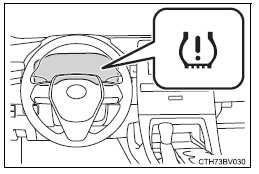
- Drive straight (with occasional left and right turns) at approximately 25 mph (40 km/h) or more for approximately 10 to 30 minutes. Registration is complete when the tire pressure warning light turns off and the inflation pressure of each tire is displayed on the multi-information display. Registration may take longer than approximately 1 hour in certain situations, such as when the vehicle is stopped for a long time at traffic lights, etc.
- After registering the ID codes, make sure to initialize the tire pressure warning system.
- When to replace your vehicle’s tires Tires should be replaced if:
- The treadwear indicators are showing on a tire.
- You have tire damage such as cuts, splits, cracks deep enough to expose the fabric, and bulges indicating internal damage
- A tire goes flat repeatedly or cannot be properly repaired due to the size or location of a cut or other damage If you are not sure, consult with your Toyota dealer.
- Replacing tires and wheels
- If the ID codes of the tire pressure warning valve and transmitters are not registered, the tire pressure warning system will not work properly. In this case, after driving for about 20 minutes, the tire pressure warning light will blink for approximately 1 minute and then illuminate to indicate a system malfunction.
- Tire life
- Any tire over 6 years old must be checked by a qualified technician even if it has seldom or never been used or damage is not obvious.
- Routine tire inflation pressure checks
- The tire pressure warning system does not replace routine tire inflation pressure checks. Make sure to check tire inflation pressure as part of your routine of daily vehicle checks.
- Low profile tires (vehicles with 18 or 19-inch wheels)
- Generally, low profile tires will wear more rapidly and tire grip performance will be reduced on snowy and/or icy roads when compared to standard tires. Be sure to use snow tires on snowy and/or icy roads and drive carefully at a speed appropriate for road and weather conditions.
- Maximum load of tire
- Check that the maximum load of the replacement tire is greater than 1/2 of the Gross Axle Weight Ratings (GAWR) of either the front axle or the rear axle, whichever is greater. For the GAWR, see the Certification Label. For the maximum load of the tire, see the load limit at maximum cold tire inflation pressure mentioned on the sidewall of the tire.

Tire types
Summer tires
Summer tires are high-speed performance tires best suited to highway driving under dry conditions. Since summer tires do not have the same traction performance as snow tires, summer tires are inadequate for driving on snow-covered or icy roads. For driving on snow-covered roads or icy roads, the use of snow tires is recommended. When installing snow tires, be sure to replace all four tires.
All season tires
All season tires are designed to provide better traction in snow and to be adequate for driving in most winter conditions as well as for use year-round. All season tires, however, do not have adequate traction performance compared with snow tires in heavy or loose snow. Also, all season tires fall short in acceleration and handling performance compared with summer tires in highway driving.
Snow tires
For driving on snow-covered roads or icy roads, we recommend using snow tires. If you need snow tires, select tires of the same size, construction and load capacity as the originally installed tires. Since your vehicle has radial tires as original equipment, make sure your snow tires also have radial construction. Do not install studded tires without first checking local regulations for possible restrictions. Snow tires should be installed on all wheels.U
If the tread on snow tires wears down below 0.16 in. (4 mm)
The effectiveness of the tires as snow tires is lost.
Situations in which the tire pressure warning system may not operate properly
- In the following situations, the tire pressure warning system may not operate properly.
- If non-genuine Toyota wheels are used.
- If a tire has been replaced with a tire that is not an OE (Original Equipment) tire.
- If a tire has been replaced with a tire that is not of the specified size.
- If tire chains, etc. are installed.
- If a window tint that affects radio wave signals is installed.
- If there is a lot of snow or ice on the vehicle, particularly around the wheels or wheel housings.
- If the tire inflation pressure is much higher than the specified level.
- If wheels not equipped with tire pressure warning valve and transmitter are used.
- If the ID codes of the tire pressure warning valve and transmitters are not registered in the tire pressure warning computer.
Performance may be affected in the following situations.
- When driving near a TV tower, electric power plant, gas station, radio station, large display, airport or other facility that generates strong radio waves or electrical noise
- When carrying a portable radio, cellular phone, cordless phone or other wireless communication device If tire position information is not correctly displayed due to the radio wave conditions, the display may be corrected by changing the location of the vehicle as the radio wave conditions may change.
- When the vehicle is stopped, the time taken for the warning to start or turn off may be longer.
- When the inflation pressure of a tire drops rapidly, for example when a tire has burst, the warning may not operate.
Initialization procedure
- Make sure to perform the initialization procedure after adjusting the tire inflation pressure. Also, make sure the tires are cold before performing the initialization procedure or adjusting the tire inflation pressure.
- If the engine switch is turned off during initialization, it is not necessary to restart the initialization procedure from the beginning as it will begin automatically when the engine switch is turned back to IGNITION ON mode.
- If initialization has accidentally been started when it is not necessary, adjust the tire inflation pressure to the specified level when the tires are cold and then perform the initialization procedure again.
- While the position of each tire is being determined and the inflation pressures are not being displayed on the multi-information display, if the inflation pressure of a tire drops, the tire pressure warning light will come on.
Warning performance of the tire pressure warning system
The warning of the tire pressure warning system will change in accordance with the conditions under which it was initialized. For this reason, the system may give a warning even if the tire pressure does not reach a low enough level, or if the pressure is higher than the pressure that was adjusted to when the system was initialized.
If the tire pressure warning system is not initialized properly
- In the following situations, initialization may take longer than usual to be completed or may not be possible. (Usually, the vehicle will need to be driven for approximately 10 to 30 minutes to complete initialization.) If initialization is not complete after driving approximately 30 minutes, continue driving for a while.
- If the vehicle is driven on an unpaved road, it may take longer to complete initialization.
- If the vehicle is backed up while performing initialization, data collected during initialization will be cleared and it will take longer than normal to complete.
- If the vehicle is driven in heavy traffic or another situation where other vehicles are driven close by, it may take time for the system to recognize the tire pressure warning valve and transmitters of your vehicle over those of other vehicles. If initialization is not complete after driving for approximately 1 hour, park the vehicle in a safe place for approximately 20 minutes and then drive the vehicle again.
In the following situations, initialization will not be started or was not completed properly and the system will not operate properly. Perform the initialization procedure again.
- If, when attempting to start initialization, the tire pressure warning light does not blink 3 times.
- If, when the vehicle has been driven for about 20 minutes after performing initialization, the tire pressure warning light blinks for approximately 1 minute and then illuminates.
- If initialization cannot be completed after performing the above procedure, contact your Toyota dealer.
When registering ID codes
- Before performing ID code registration, make sure that no wheels with tire pressure warning valve and transmitters installed are near the vehicle.
- Make sure to initialize the tire pressure warning system after registering the ID codes. If the system is initialized before registering the ID codes, the initialized values will be invalid.
- As the tires will be warm when registration is completed, make sure to allow the tires to cool before performing initialization.
Canceling ID code registration
- To cancel ID code registration after it has been started, turn the engine switch off before driving the vehicle. If the vehicle is driven after ID code registration is started, to cancel registration, perform the ID code registration start procedure again and turn the engine switch off before driving.
- If ID code registration has been canceled, the tire pressure warning light will blink for approximately 1 minute when the engine switch is turned to IGNITION ON mode and then illuminate.
- The tire pressure warning system will be operational when the tire pressure warning light turns off.
- If the warning light does not turn off even after several minutes have elapsed, ID code registration may not have been cancelled correctly. To cancel registration, perform the ID code registration start procedure again and then turn the engine switch off before driving.
If ID codes are not registered properly
- In the following situations, ID code registration may take longer than usual to be completed or may not be possible. (Usually, the vehicle will need to be driven for approximately 10 to 30 minutes to complete ID code registration.) If ID code registration is not complete after driving for approximately 30 minutes, continue driving for a while.
- If the vehicle is driven on an unpaved road, it may take longer than normal to complete registration.
- If the vehicle is backed up while performing registration, data collected during registration will be cleared, and it will take longer than normal to complete
- If the vehicle is driven in heavy traffic or another situation where other vehicles are driven close by, it may take time for the system to recognize the tire pressure warning valve and transmitters of your vehicle over those of other vehicles.
- If a wheel with a tire pressure warning valve and transmitter installed is inside or near the vehicle, registration of the ID codes for the installed wheels may not be possible. If ID registration is not complete after driving for approximately 1 hour, park the vehicle in a safe place for approximately 20 minutes and then perform the ID code registration procedure again.
- In the following situations, ID code registration will not be started or was not completed properly and the system will not operate properly. Perform the ID code registration procedure again.
- If, when attempting to start ID code registration, the tire pressure warning light does not blink slowly 3 times.
- If, when the vehicle has been driven for about 20 minutes after performing ID code registration, the tire pressure warning light blinks for approximately 1 minute and then illuminates.
- If ID code registration cannot be completed after performing the above procedure, contact your Toyota dealer.
Tire pressure warning system certification
For vehicles sold in the U.S.A.
FCC ID: PAXPMVE000
NOTE
This device complies with part 15 of the FCC Rules. Operation is subject to the following two conditions:
- This device may not cause harmful interference, and
- this device must accept any interference received, including interference that may cause undesired operation.
FCC WARNING
Changes or ·modifications not expressly approved by the party responsible for compliance could void the user s authority to operate the equipment.
For vehicles sold in Canada
Model: PMV-E000
NOTE
This device complies with Industry Canada licence-exempt I RSS standard(s). Operation is subject to the following two conditions:
- this device may not cause interference, and
- this device must accept any interference, including interference that may cause undesired operation of the device.
WARNING
- When inspecting or replacing tires Observe the following precautions to prevent accidents. Failure to do so may cause damage to parts of the drive train as well as dangerous handling characteristics, which may lead to an accident resulting in death or serious injury.
- Do not mix tires of different makes, models or tread patterns. Also, do not mix tires of remarkably different treadwear.
- Do not use tire sizes other than those recommended by Toyota.
- Do not mix differently constructed tires (radial, bias-belted, or bias-ply tires).
- Do not mix summer, all season, and snow tires.
- Do not use tires that have been used on another vehicle. Do not use tires if you do not know how they were used previously.
- When initializing the tire pressure warning system Do not initialize the tire pressure warning system without first adjusting the tire inflation pressure to the specified level. Otherwise, the tire pressure warning light may not come on even if the tire inflation pressure is low, or it may come on when the tire inflation pressure is actually normal.
NOTICE
- Repairing or replacing tires, wheels, tire pressure warning valve, and transmitters, and tire valve caps
- When removing or fitting the wheels, tires or the tire pressure warning valve and transmitters, contact your Toyota dealer as the tire pressure warning valve and transmitters may be damaged if not handled correctly.
- Make sure to install the tire valve caps. If the tire valve caps are not installed, water may enter the valves of the tire pressure warning valve and transmitters and the valves may become stuck.
- When replacing tire valve caps, do not use tire valve caps other than those specified. The cap may become stuck.
- To avoid damage to the tire pressure warning valve and transmitters When a tire is repaired with liquid sealants, the tire pressure warning valve and transmitter may not operate properly. If a liquid sealant is used, contact your Toyota dealer or another qualified service shop as soon as possible. Make sure to replace the tire pressure warning valve and transmitter when replacing the tire.
- Driving on rough roads Take particular care when driving on roads with loose surfaces or potholes. These conditions may cause losses in tire inflation pressure, reducing the cushioning ability of the tires. In addition, driving on rough roads may cause damage to the tires themselves, as well as the vehicle’s wheels and body.
- Low profile tires (vehicles with 18 or 19-inch wheels) Low profile tires may cause greater damage than usual to the tire wheel when sustaining impact from the road surface. Therefore, pay attention to the following:
- Be sure to use proper tire inflation pressure. If tires are under-inflated, they may be damaged more severely.
- Avoid potholes, uneven pavement, curbs and other road hazards. Failure to do so may lead to severe tire and wheel damage.
- If tire inflation pressure of each tire becomes low while driving Do not continue driving, or your tires and/or wheels may be ruined.
Tire inflation pressure
Tire inflation pressure
The recommended cold tire inflation pressure and tire size are displayed on the tire and loading information label. 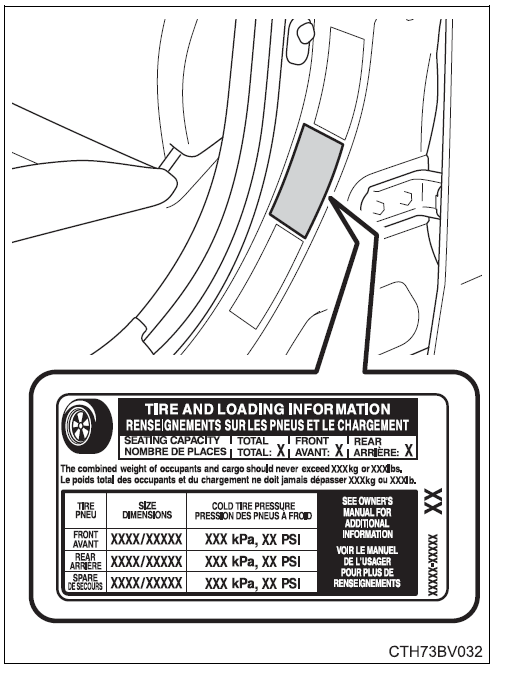
Inspection and adjustment procedure
- Tire valve
- Tire pressure gauge

Tire pressure gauge
- Remove the tire valve cap.
- Press the tip of the tire pressure gauge onto the tire valve.
- Read the pressure using the gauge gradations.
- If the tire inflation pressure is not at the recommended level, adjust the pressure. If you add too much air, press the center of the valve to deflate.
- After completing the tire inflation pressure measurement and adjustment, apply soapy water to the valve and check for leakage.
- Put the tire valve cap back on.
Tire inflation pressure check interval
You should check tire inflation pressure every two weeks, or at least once a month.
- Effects of incorrect tire inflation pressure Driving with incorrect tire inflation pressure may result in the following:
- Reduced fuel economy
- Reduced driving comfort and poor handling
- Reduced tire life due to wear
- Reduced safety
- Damage to the drivetrain If a tire needs frequent inflating, have it checked by your Toyota dealer. Instructions for checking tire inflation pressure When checking tire inflation pressure, observe the following:
- Check only when the tires are cold. If your vehicle has been parked for at least 3 hours or has not been driven for more than 1 mile or 1.5 km, you will get an accurate cold tire inflation pressure reading.
- Always use a tire pressure gauge. It is difficult to judge if a tire is properly inflated based only on its appearance.
- It is normal for the tire inflation pressure to be higher after driving as heat is generated in the tire. Do not reduce tire inflation pressure after driving.
- Never exceed the vehicle capacity weight. Passengers and luggage weight should be placed so that the vehicle is balanced.
WARNING
Proper inflation is critical to save tire performance Keep your tires properly inflated. If the tires are not properly inflated, the following conditions may occur which could lead to an accident resulting in death or serious injury:
- Excessive wear
- Uneven wear
- Poor handling
- Possibility of blowouts resulting from overheated tires
- Air leaking from between tire and wheel
- Wheel deformation and/or tire damage
WARNING
Greater possibility of tire damage while driving (due to road hazards, expansion joints, sharp edges in the road, etc.)
NOTICE
When inspecting and adjusting tire inflation pressure Be sure to put the tire valve caps back on.If a valve cap is not installed, dirt or moisture may get into the valve and cause an air leak, resulting in decreased tire inflation pressure.
Wheels
If a wheel is bent, cracked or heavily corroded, it should be replaced. Otherwise, the tire may separate from the wheel or cause a loss of handling control.
Wheel selection
When replacing wheels, care should be taken to ensure that they are equivalent to those removed in load capacity, diameter, rim width and inset*. Replacement wheels are available at your Toyota dealer. *: Conventionally referred to as offset. Toyota does not recommend using the following:
- Wheels of different sizes or types
- Used wheels
- Bent wheels that have been straightened
Aluminum wheel precautions
- Use only Toyota wheel nuts and wrenches designed for use with your aluminum wheels.
- When rotating, repairing or changing your tires, check that the wheel nuts are still tight after driving 1000 miles (1600 km).
- Be careful not to damage the aluminum wheels when using tire chains.
- Use only Toyota genuine balance weights or equivalent and a plastic or rubber hammer when balancing your wheels.
When replacing wheels
The wheels of your vehicle are equipped with tire pressure warning valves and transmitters that allow the tire pressure warning system to provide advance warning in the event of a loss in tire inflation pressure. Whenever wheels are replaced, tire pressure warning valves and transmitters must be installed
WARNING
- Do not use wheels that are a different size from those recommended in the Owner’s Manual, as this may result in a loss of handling control.
- Never use an inner tube in a leaking wheel that is designed for a tubeless tire. Doing so may result in an accident, causing death or serious injury.
When installing the wheel nuts
- Never use oil or grease on the wheel bolts or wheel nuts. Oil and grease may cause the wheel nuts to be excessively tightened, leading to bolt or disc wheel damage. In addition, the oil or grease can cause the wheel nuts to loosen and the wheel may fall off, causing an accident and resulting in death or serious injury. Remove any oil or grease from the wheel bolts or wheel nuts.
Use of defective wheels prohibited
- Do not use cracked or deformed wheels. Doing so could cause the tire to leak air during driving, possibly causing an accident.
NOTICE
- Replacing tire pressure warning valves and transmitters
- Because tire repair or replacement may affect the tire pressure warning valves and transmitters, make sure to have tires serviced by your Toyota dealer or another qualified service shop. In addition, make sure to purchase your tire pressure warning valves and transmitters at your Toyota dealer
- Ensure that only genuine Toyota wheels are used on your vehicle. Tire pressure warning valves and transmitters may not work properly with non-genuine wheels.
Air conditioning filter
The air conditioning filter must be changed regularly to maintain air conditioning efficiency.
Removal method
- Turn the engine switch off.
- Open the glove box and remove the glove box cover inside the glove box.
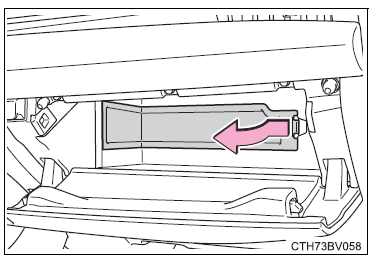
- Remove the filter cover.
- Unlock the filter cover.
- Move the filter cover in the direction of the arrow, and then pull it out of the claws.

- Remove the filter case. There may be foreign objects on top of the air conditioning filter

- Remove the air conditioning filter from the filter case and replace it with a new one. The “UP” marks shown on the filter and the filter case should be pointing up.
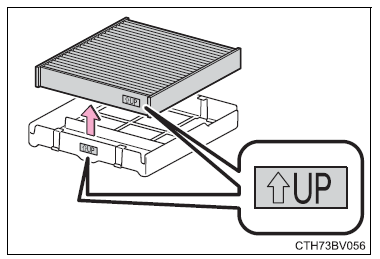
Checking interval
Inspect and replace the air conditioning filter according to the maintenance schedule. In dusty areas or areas with heavy traffic flow, early replacement may be required. (For scheduled maintenance information, please refer to the “Schedule maintenance guide” or “Owner’s Manual Supplement”.)
If airflow from the vents decreases dramatically
The filter may be clogged. Check the filter and replace if necessary
Air conditioning filter with deodorizing function
When fragrances are placed in your vehicle, the deodorizing effect may become significantly weakened in a short period. When an air conditioning odor comes out continuously, replace the air conditioning filter.
NOTICE
- When using the air conditioning system Make sure that a filter is always installed. Using the air conditioning system without a filter may cause damage to the system.
- To prevent damage to the filter cover When moving the filter cover in the direction of arrow to release the fitting, pay attention not to apply excessive force to the claws.
- Otherwise, the claws may be damaged.
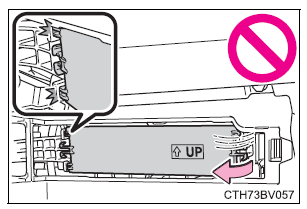
Electronic key battery
Replace the battery with a new one if it is depleted.
You will need the following items:
- Flathead screwdriver
- Small flathead screwdriver
- Lithium battery CR2032
Replacing the battery
- Release the lock and remove the mechanical key.
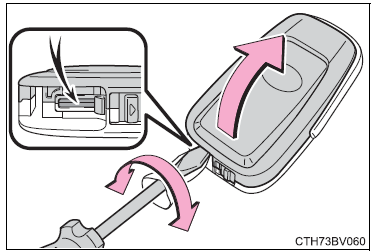
- Remove the key cover. To prevent damage to the key, cover the tip of the flathead screwdriver with a rag.
- Remove the depleted battery using a small flathead screwdriver.

- When removing the cover, the electronic key module may stick to the cover and the battery may not be visible.
- In this case, remove the electronic key module in order to remove the battery.
- Insert a new battery with the “+” terminal facing up.
- When installing the key cover and mechanical key, install by conducting and with the directions reversed.
- Operate the
 switch and check that the doors can be locked/unlocked.
switch and check that the doors can be locked/unlocked.
When replacing the key battery
Be careful not to lose the battery or any other small parts.
Use a CR2032 lithium battery
- Batteries can be purchased at your Toyota dealer, local electrical appliance shops or camera stores.
- Replace only with the same or equivalent type recommended by the manufacturer.
- Dispose of used batteries according to local laws.
If the key battery is depleted
- The following symptoms may occur:
- The smart key system and wireless remote control will not function properly.
- The operational range will be reduced
WARNING
- Battery precautions
- Observe the following precautions.
- Failure to do so may result in death or serious injury.
- Do not swallow the battery.
- Doing so may cause chemical burns.
- A coin battery or button battery is used in the electronic key.
- If a battery is swallowed, it may cause severe chemical burns in as little as 2 hours and may result in death or serious injury.
- Keep away new and removed batteries from children.
- If the cover cannot be firmly closed, stop using the electronic key and stow the key in the place where children cannot reach, and then contact your Toyota dealer.
- If you accidentally swallow a battery or put a battery into a part of your body, get emergency medical attention immediately.
- To prevent battery explosion or leakage of flammable liquid or gas
- Replace the battery with a new battery of the same type. If a wrong type of battery is used, it may explode.
- Do not expose batteries to extremely low pressure due to high altitude or extremely high temperatures.
- Do not burn, break or cut a battery.
NOTICE
- For normal operation after replacing the battery
- Observe the following precautions to prevent accidents:
- Always work with dry hands.
- Moisture may cause the battery to rust.
- Do not touch or move any other component inside the remote control.
- Do not bend either of the battery terminals.
Checking and replacing fuses
If any of the electrical components do not operate, a fuse may have blown. If this happens, check and replace the fuses as necessary
- Turn the engine switch off.
- Open the fuse box cover
- Engine compartment
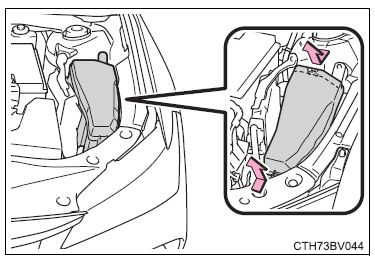
- Engine compartment (type B) (if equipped)

- Under the driver’s side instrument panel
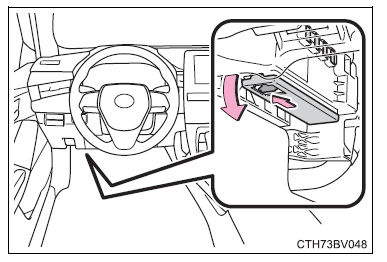
- Remove the fuse with the pullout tool
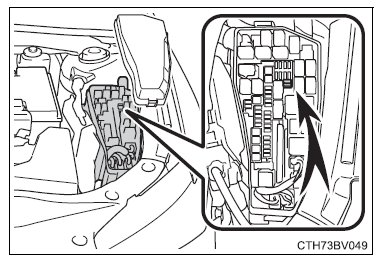
Type A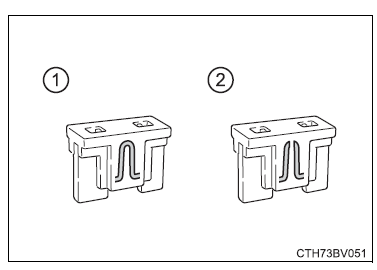 Type B
Type B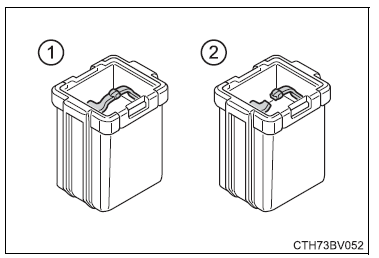 Type C
Type C
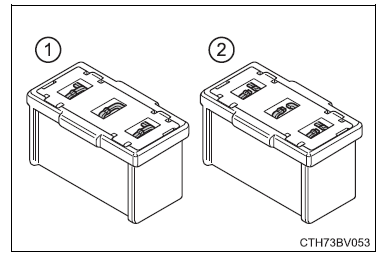
After a fuse is replaced
- If the lights do not turn on even after the fuse has been replaced, a bulb may need replacement.
- If the replaced fuse blows again, have the vehicle inspected by your Toyota dealer.
- If there is an overload in a circuit
- The fuses are designed to blow, protecting the wiring harness from damage.
WARNING
- To prevent system breakdowns and vehicle fire Observe the following precautions. Failure to do so may cause damage to the vehicle, and possibly a fire or injury.
- Never use a fuse of a higher amperage rating than that indicated, or use any other object in place of a fuse.
- Always use a genuine Toyota fuse or equivalent. Never replace a fuse with a wire, even as a temporary fix.
- Do not modify the fuses or fuse boxes.
NOTICE
Before replacing fuses Have the cause of electrical overload determined and repaired by your Toyota dealer as soon as possible.
Light bulbs
If any lights burn out, have it replaced by your Toyota dealer.
LED lights
The lights consist of a number of LEDs. If any of the LEDs burn out, take your vehicle to your Toyota dealer to have the light replaced.
Condensation build-up on the inside of the lens
Temporary condensation build-up on the inside of the headlight lens does not indicate a malfunction.
- Contact your Toyota dealer for more information in the following situations:
- Large drops of water have built up on the inside of the lens.
- Water has built up inside the headlight.
Back-up light
- Bulbs that need to be replaced by your Toyota dealer
- Headlights
- Parking lights/daytime running lights
- Front turn signal lights
- Side marker lights
- Stop/tail lights
- Rear turn signal lights
- High mounted stoplight
- License plate lights
- Door courtesy lights (if equipped)
LED light bulbs
The lights other than the back-up light each consist of a number of LEDs. If any of the LEDs burn out, take your vehicle to your Toyota dealer to have the light replaced.
Condensation build-up on the inside of the lens
Temporary condensation build-up on the inside of the headlight lens does not indicate a malfunction. Contact your Toyota dealer for more information in the following situations:
- Large drops of water have built up on the inside of the lens.
- Water has built up inside the headlight.
FAQ
Answer: Typically, for modern vehicles with synthetic oil, the interval can range from 5,000 to 10,000 miles. Always refer to the owner’s manual for the recommended oil change interval specific to the 2022 Avalon.
Answer: The engine air filter is usually located in a plastic housing in the engine compartment. To replace it, unclamp the housing, replace the filter, and securely close the housing.
Answer: Yes, the cabin air filter is often located behind the glove compartment or under the dashboard. Once accessed, you can replace it with a new one. Check the owner’s manual for specific instructions.
Answer: Use a tire pressure gauge by placing it on the valve stem of each tire. Ensure the tires are cold for the most accurate reading. The recommended tire pressure can be found in the owner’s manual or on the driver’s side door jamb.
Answer: Tire rotation is generally recommended every 5,000 to 7,500 miles, but always refer to the owner’s manual for the specific interval for the Avalon.
Answer: The Avalon usually has multiple fuse boxes, commonly located under the dashboard and in the engine compartment. Check the owner’s manual for exact locations and a diagram of which fuse corresponds to each function.
Answer: Open the hood and locate the brake fluid reservoir. The fluid level should be between the “MIN” and “MAX” lines. If it’s low, top it up with the recommended brake fluid.
Answer: Yes, wiper blades can be replaced by sliding or unclipping the old blades off and attaching the new ones. Ensure you purchase the correct size for your Avalon.
Answer: It’s a good practice to check the coolant level during every oil change. Ensure the engine is cool, and check that the coolant level is between the “MIN” and “MAX” lines in the reservoir.
Answer: Most key fobs have a small slot or notch to open them with a flat-head screwdriver. Once open, replace the old battery with a new one, ensuring the polarity is correct.
Answer: The specific grade and type can be found in the owner’s manual. Many modern cars use synthetic or synthetic blend oils.
Answer: Yes, by accessing the back of the headlight assembly from the engine compartment. Remove the old bulb and insert the new one. Ensure not to touch the bulb with bare hands as oils can reduce its lifespan.
Answer: Procedures can vary. Commonly, it involves turning the ignition to the “ON” position without starting the engine and pressing the odometer reset button. Refer to the owner’s manual for specific steps.
Answer: Inspect it regularly for cracks or wear. Many manufacturers recommend replacing it every 60,000 to 100,000 miles, but check the owner’s manual for the Avalon’s specific recommendation.
Answer: Transmission fluid intervals can vary greatly, often between 30,000 and 100,000 miles. Always check the owner’s manual for the recommended interval specific to the 2022 Avalon.
Useful Link
Toyota Avalon 2022 User Guide
Download Manuals:https://www.toyota.com/owners/resources/warranty-owners-manuals


